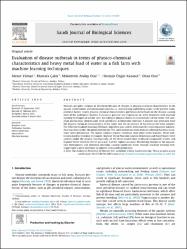| dc.contributor.author | Yılmaz, Mesut | |
| dc.contributor.author | Çakır, Mustafa | |
| dc.contributor.author | Oral, Mükerrem Atalay | |
| dc.contributor.author | Kazancı, Hüseyin Özgür | |
| dc.date.accessioned | 2023-12-26T06:23:16Z | |
| dc.date.available | 2023-12-26T06:23:16Z | |
| dc.date.issued | 2023 | en_US |
| dc.identifier.citation | Yilmaz, M., Çakir, M., Oral, M.A., Kazanci, H.Ö., Oral, O. (2023). Evaluation of disease outbreak in terms of physico-chemical characteristics and heavy metal load of water in a fish farm with machine learning techniques. Saudi Journal of Biological Sciences, 30 (4), art. no. 103625.
https://doi.org/10.1016/j.sjbs.2023.103625 | en_US |
| dc.identifier.issn | 1319-562X | |
| dc.identifier.issn | 2213-7106 | |
| dc.identifier.uri | https://doi.org/10.1016/j.sjbs.2023.103625 | |
| dc.identifier.uri | https://hdl.handle.net/20.500.12508/2800 | |
| dc.description.abstract | Diseases are quite common in fish farms because of changes in physico-chemical characteristics in the aquatic environment, and operational concerns, i.e., overstocking and feeding issues. In the present study, potential factors (water physico-chemical characteristics and heavy metal load) on the disease-causing state of the pathogenic bacteria Lactococcus garvieae and Vagococcus sp. were examined with machine learning techniques in a trout farm. Recording of physico-chemical characteristics of the water, fish sampling and bacteria identification were carried out at bimonthly intervals. A dataset was generated from the physico-chemical characteristics of the water and the occurrence of bacteria in the trout samples. The eXtreme Gradient Boosting (XGBoost) algorithm was used to determine the most important independent variables within the generated dataset. The most important seven features affecting bacteria occurrence were determined. The model creation process continued with these seven features. Three well-known machine learning techniques (Support Vector Machine, Logistic Regression and Naïve Bayes) were used to model the dataset. Consequently, all the three models have produced comparable results, and Support Vector Machine (93.3% accuracy) had the highest accuracy. Monitoring changes in the aquaculture environment and detecting situations causing significant losses through machine learning techniques have a great potential to support sustainable production. | en_US |
| dc.language.iso | eng | en_US |
| dc.publisher | Elsevier | en_US |
| dc.relation.isversionof | 10.1016/j.sjbs.2023.103625 | en_US |
| dc.rights | info:eu-repo/semantics/openAccess | en_US |
| dc.subject | Aquaculture | en_US |
| dc.subject | Heavy metal load | en_US |
| dc.subject | Machine learning | en_US |
| dc.subject | Pathogenic bacteria | en_US |
| dc.subject | Rainbow trout | en_US |
| dc.subject.classification | Lactococcus Garvieae | |
| dc.subject.classification | Streptococcus Iniae | |
| dc.subject.classification | Fish | |
| dc.subject.classification | Electrical Engineering, Electronics & Computer Science
- Security Systems
- Blockchain | |
| dc.subject.other | Oncorhynchus-mykiss | |
| dc.subject.other | Rainbow-trout | |
| dc.title | Evaluation of disease outbreak in terms of physico-chemical characteristics and heavy metal load of water in a fish farm with machine learning techniques | en_US |
| dc.type | article | en_US |
| dc.relation.journal | Saudi Journal of Biological Sciences | en_US |
| dc.contributor.department | İskenderun Meslek Yüksekokulu -- İnsansız Hava Aracı Teknolojisi ve Operatörlüğü Bölümü | en_US |
| dc.identifier.volume | 30 | en_US |
| dc.identifier.issue | 4 | en_US |
| dc.relation.publicationcategory | Makale - Uluslararası Hakemli Dergi - Kurum Öğretim Elemanı | en_US |
| dc.contributor.isteauthor | Çakır, Mustafa | |
| dc.relation.index | Web of Science - Scopus - PubMed | en_US |
| dc.relation.index | Web of Science Core Collection - Science Citation Index Expanded | |
















